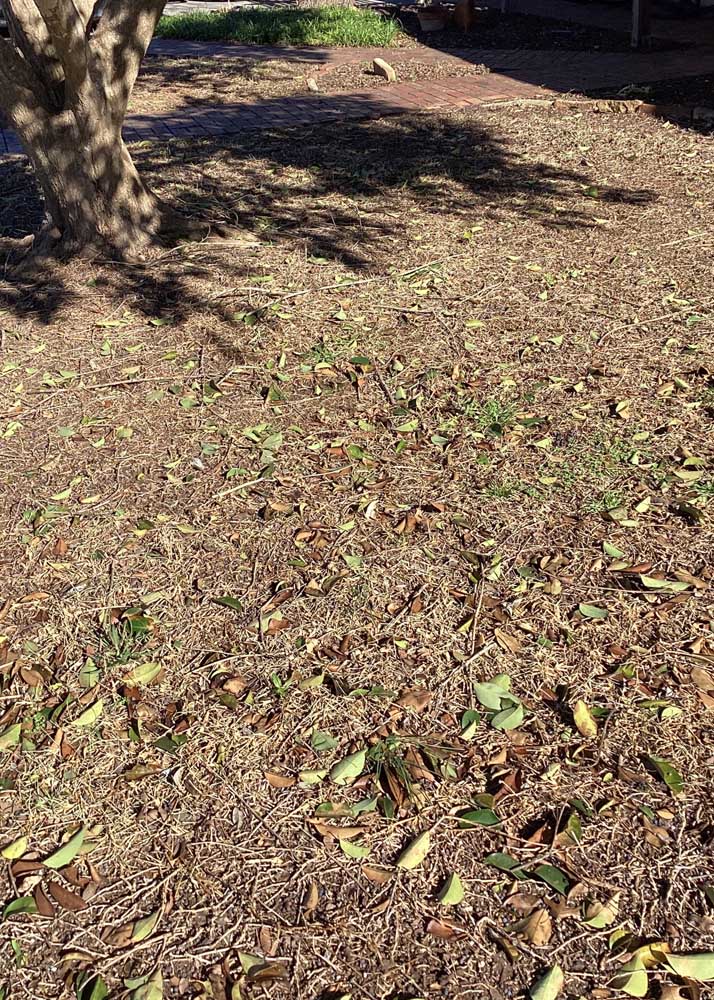Sperry: Texas heat a problem for some, while others need plenty of sun
Published 5:00 am Sunday, February 11, 2024

- St. Augustine in this lawn has died, likely due to too much shade.
Dear Neil: I’ve had robust St. Augustine for 40 years, but suddenly the past two summers it has plunged into deep decline. I was told it was chinch bugs or grub worms, and someone else suspected a fungus. I’ve done everything that was suggested for the past two years. Do you have any further recommendations from my photos?
Chinch bug damage would have shown up in the summer, so that leaves it on the table. Grub worm damage shows up in late fall or the following spring, so they’re probably out of consideration. If the dieback was uniform across the entire lawn I doubt if it was a fungus. They generally appear in patches or small spaces. So, I’ll go back to the possibility of chinch bug damage. It was widespread across Texas the past two summers. However, chinch bugs always become a problem in full sun – the hottest, sunniest parts of your yard. That doesn’t appear to be the case as judging from your photos.
Trending
My guess, especially since you said that insecticides and fungicides didn’t help at all, would be that it’s thinning out because of the shade. St. Augustine may be more tolerant of shade than other types of turfgrass, but it still requires six hours of direct sunlight daily. Watch as things green up this spring to see if the die out is worst where the shade is heaviest.
That’s the single biggest problem I see people having with lawngrasses, and there does come a time, after all the tree trimming and thinning are done, that all you can do is replace the grass with a more shade-tolerant plant. In my case, I took out a couple of trees that weren’t contributing much to the looks of our landscape and removed one or two lower branches, but the St. Augustine was still thin in many areas. I have switched over to mondograss (monkeygrass) as a replacement, and I’ve been very satisfied with the outcome. I have used regular mondograss, not the much slower and far less dependable dwarf mondo.
Dear Neil: We have just moved to Texas from Indiana. Why is Kentucky bluegrass not planted here?
It’s our heat, day and night. I grew up in Texas, and I asked the very same question of my Turf Management professor when I transferred from A&M to Ohio State. He compared it to a bank account, saying that bluegrass used so much of its stored energy just staying alive in the heat that it exhausted its supplies – like a person overdraws their bank account. That’s why a plant can withstand a few days of very hot weather, but not a whole summer’s worth.
Dear Neil: Are concrete pavers over a tree’s root systems less harmful that pouring concrete would be?
Yes, probably. Air and water can move in and out of the soil through the cracks between the pavers, so the tree’s roots will be able to develop normally. We have them for our driveway and have had no problem for almost 40 years. There is one other decided advantage, and that is that if a root decides to grow and swell, you can lift out the pavers, eliminate the root and put the pavers back in place. You can’t do that with a concrete drive without a noticeable patch. As the pavers are installed, however, try to do as little grade changing as possible.
Trending
Dear Neil: My husband passed away last year. He was an avid gardener, and we had everything from fruit trees and grape vines to asparagus, garlic, pecans, roses, and flower bulbs. I had a broken ankle and was in a wheelchair for six months. Even in perfect health I am not the gardener he was, and I don’t know where to start keeping things beautiful. I have learned quite an appreciation for those who are successful at this hobby. Do you have any advice on how I can keep things going?
That’s a tough assignment, and it will probably cause frustration along the way, so be patient with yourself. I would suggest that you simplify. Identify those plants that meant the most to you and to your husband and spend your time nurturing them. Those that are a burden can be given away or taken out. (Hope that didn’t come across as abrupt.) There is nothing wrong with a tasteful, simple landscape and garden. If he had large flowerbeds, change over to container gardens near the entry. If you don’t enjoy cooking as much now as before, don’t worry about vegetables unless you have a means of sharing them with others.
There are several excellent reference books on the market that have been written specifically for Texas, and the Texas A&M Extension horticulture website has a great deal of good information. So will websites from Oklahoma State, North Carolina State, L.S.U., and Clemson, among others. Look for help at member nurseries of the Texas Nursery and Landscape Association, specifically from Texas Certified and Texas Master Certified Nursery Professionals. They have studied long and hard hours and their advice is timely and reliable. Good luck! I’m sorry you’re having to face this alone.






